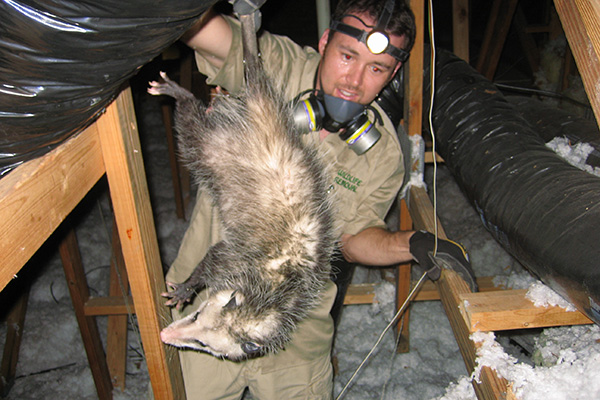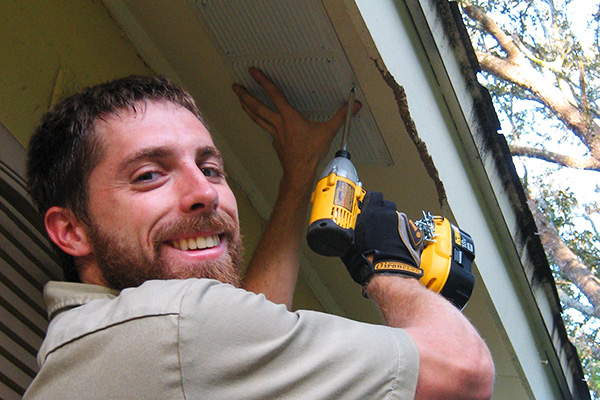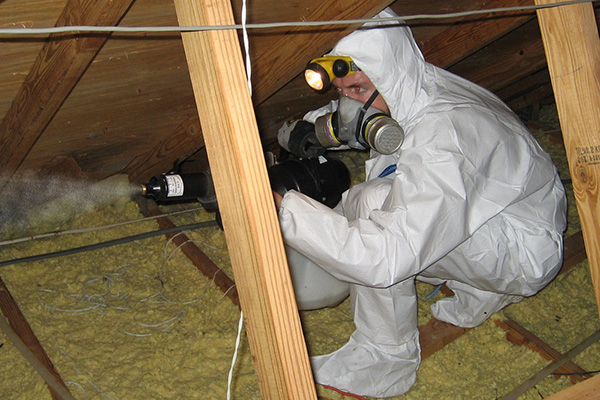Most of the time, YES. The most common reason an animal enters the attic of a home is the have a safe place to give birth to and raise a nest of young. Almost every time, a raccoon or a squirrel in your attic is a single female, who will soon give birth to a litter of 3-5 babies. Many people do not even realize they have animals in their attic until these young start to make noise. Baby raccoons, for example, have a distinct vocal chatter. Baby squirrels grow very quickly, and are near adult size within six weeks, at which time your attic has been transformed from a place with one active squirrel to five active squirrels, and you really notice it then! This nest of babies is a matter of high concern. You can't simply trap and remove the adult female and leave the nest of young behind. Depending on their age, they will scratch and claw, and if they can't get out and then die, they will rot and stink. It is extremely inhumane to leave the nest of babies behind. Most of the time, they must be removed by hand. In addition, birds, rats, mice, opossums, and especially bats enter an attic and rear young. Read more about nest of baby animals in the attic.
- info@animalatticpest.com
- Call - we service 300 locations

What To Do About Animals In Your Attic
So, you have animals in your attic! You probably hear them scurrying or scratching or thumping. Maybe you have seen them go in and out of your house. Don't worry, the problem is fixable. This website will educate you on the proper methods to remove the animal or animals from your attic, and prevent the problem from happening again. We discuss in detail the most common wildlife species, and which approach is the most effective for each. The removal of raccoons from an attic is very different from the removal of mice! Bats require a very specific special technique. The focus of this site is on the most effective way to solve the problem permanently, while treating wildlife humanely and respectfully. We also discuss all of the variables and potential issues to look out for. Although each critter species is different, and each situation is different, the general process is as such: First, inspect the house to find out how the animals are getting inside. Second, inspect the attic to find out what kind of damage they have caused, and to confirm which species of animal you have. Third, remove the animals, via either trapping or one-way exclusion doors or by hand. Fourth, repair and seal shut all the entry holes after the animals are out. Fifth, repair any damage and clean and decontaminate the attic if necessary. You may want to get rid of animals in the attic fast and easy, but it is work.
Solve the Problem - 4 How-To Steps
1 - Home & Attic Inspection
Inspect the exterior of the home, including the roof and all vents, to find out how the animals are getting in. Also inspect inside the attic to identify animal and damage.
2 - Remove the Animals
This process is not simple, and it varies considerably based on animal type and situation. You might use an exclusion door, or a cage trap, or removal by hand.
3 - Repair the Entry Holes
The job is not complete until you solve the source of the problem. Seal shut the entry holes, with professional grade repairs, or else the problem will happen again.
4 - Clean the Attic
In addition to repairing chewed electrical wires and damaged duct work, you might want to remove the animal feces, maybe the insulation, and decontaminate.
Frequently Asked Questions About Animals in the Attic
Most people object to the noise, at first. But critters in the attic can cause damage. First of all, they always defecate and urinate in the attic. This can cause odor problems, a breeding ground for mold, is host to potential pathogens and health risks, and the odor can contain phermonones that attract other animals into the attic. Sometimes the feces or urine can leak through the drywall and onto your ceiling. I have seen that many times. Be sure not to touch or even disturb animal feces in an attic. Read more about animal feces in the attic. Second, animals can bring in food and nesting debris. Squirrels in particular often bring in large piles of leaves and plant material. Third, animals often trample down the insulation, lowering its R-value and effectiveness. This is very common with larger animals like raccoons. Finally, animals can sometimes cause real destruction. Rodents love to chew, and often chew on electrical wires in the attic, creating a potential fire hazard. I've also seen them chew pvc pipe in houses with attic plumbing, which results in big water leaks. In addition, I've seen raccoons, for who knows what reason, simply tear up all the air conditioning and heating duct work in an attic. Some animals also chew on wood beams or rip lining paper. Also, it's important to note that most animals cause damage to get in - torn open vents, chewed-open fascia boards, and so on. The level of damage varies. Sometimes it's quite subtle, sometimes it is severe. Read more about damage from animals in the attic.
If you don't know what species of animal has invaded your attic, there are many clues. Start with the noise - the time you hear it is a big clue. If the noise is during the day, especially in the early morning or evening before sunset, then it's almost surely squirrels. If the noise of the animal in the attic is at night, it's probably raccoons, rats, or another nocturnal animal. How about the location of the sound? If it's in a wall or a very tight space, it's probably a rodent like rats or mice. What about the volume? The heavier the thumping and walking, the larger the animal, such as a raccoon or opossum. If it's fast and light scampering, it's probably a rat or mouse (or squirrel, during the daytime). Read more about noises in the attic. There are other clues - when you inspect the exterior of the house, you'll find the entry holes. If it's a large hole with damage, like a torn open roof or a busted eave, that's a raccoon! If it's a hole maybe 2 inches in diameter with chewing around the perimeter, that's squirrel. If it's small gaps, perhaps with brown grease, that's rats or mice. There are many other clues on your house, such as footprints, hair, and so on. Finally, the inspection in the attic is the real clincher. There you will find tracks, and most importantly, feces. If you know how to identify these, you will know your culprit. If you have experience like me, you will actually know right away by the odor in the attic! Each animal has a trademark scent. Rarely will you actually see the animals in the attic. It happens for me less than 5% of the time. Most of the time the animals will crawl down a dark wall or under insulation, or in the shadows, and stay super still. But when you read the signs, it's easy to identify what animals you have. Whether it's animals in the attic at night or day, identification is key. Read more about what type of animals are in my attic.
This is the most important part. You must do a full inspection of the house to find 100% of the entry holes. Sometimes an animal will have a single obvious entry hole, sometimes there will be dozens of small areas. A larger animal like a raccoon is usually pretty obvious! But when you have rats or mice or bats in your attic, it's possible that they are able to enter through dozens of different areas, from the ground to the roof. It could be a problem with the architecture at large, such as a tile roof with gaps, or loose siding, or a unscreened vents. Or it could be vulnerabilities such as wood eaves. It could even be the chimney. An experienced wildlife expert will know what to look for, and this is what separates the good professionals from the amatuers. The most common reason for a failed job, a failure to remove the animals from the attic, stems from an initial failure to properly identify all the entry areas. A solid understanding of building architecture and animal behavior is essential here. Read more about building inspection to find entry holes.
In my 15+ years as a wildlife removal professional, I have seen it all: attics filled with strobing lights, blaring radios, ultrasonic sound machines, and every type of over-the-counter repellent, from coyote urine flakes, to ammonia, to the end-all-be-all el cheapo scam, mothballs. I once went into an attic in which a desperate old lady had dumped close to 100 lbs. of mothballs in her attic. It reeked, she suffered from headaches and respiratory issues, and guess what? The squirrels didn't care! Here's the problem with repellents in general: once a wild animal lives in your attic, and has a nest of babies there, that's it. That's the only option for survival. They will endure anything rather than to leave and die outside without shelter. There is no device, no repellent that will make them leave. It's a life-or-death scenario, and a bad noise or bad smell doesn't do the trick. Go ahead and buy them - waste your time. But they have zero demonstrated effectiveness. The only way to actually solve a problem with wildlife in the attic is to identify the entry holes, seal them shut, and either physically trap or exclude the animals from the building. Read more about animal repellents.
I know how to solve the problem, just kill 'em!" It's possible, but killing animals in the attic is actually much more difficult than exclusion or trapping, and less effective. You could set lethal traps by the animal holes, but these traps are very difficult to set, not to mention dangerous. And they only get one animal at a time, so they are ineffecient. What about poison then? There are no registered rodenticides for any animal other than rats or mice, but even those animals should not be controlled with rodenticides. All other animals like raccoons and squirrels never eat food in an attic, so unlike with rats, they will not consume rat poison, and the poison is not designed for most animals, so if they did eat it, they may not die. Also, if you do manage to kill one with poison, the smell of a rotting squirrel is terrible. Any of these attempts are inhumane of course, if you care, which you might not if your top interest is killing them. I understand if you may hate the vermin in the attic, or think that killing them is the logical approach and so on, but seriously, it's a lot more challenging to kill wildlife than to install a one-way exclusion door or a repeater trap. Most of all, poison does not address the root of the problem, and that is the open holes in your house that allow the animals to get inside. If those openings remain, you will never solve a problem with animals in the attic. Read more about how to kill animals in the attic.
You can do it yourself with careful research, and a very diligent approach to do it correctly. You must use a ladder to inspect every part of your roof and all your vents. You must inspect the attic and find the nest of baby animals. You must reseach the correct type of trap(s) to use in your situation, and buy them, and set them correctly. It is not easy! Almost every amateur wildlife control attempt I have seen has resulted in failure or suffering for animals. Are you aware that a trap set inside the attic itself will never catch a squirrel, but will almost always catch an opossum? Are you aware that with squirrels you seal all but the primary exit hole? Are you aware that with raccoons you leave the hole open, but with rats you seal all the holes first? Do you know the time of year and when the different species give birth? And the legalities of trapping, including the time of year? It's very complex and experience in trap setting is crucial. There are so many small details. It's not as easy as plumbing or electrical work, which I consider simple do-it-yourself homeowner projects. I... just generally do not recommend do-it-yourself removal of wildlife from attics. You are of course welcome to try, and I do my best to explain how on this website. But if you need professional help, I have compiled a list of the best wildlife control experts in the USA, many of them personally trained by myself. We service over 95% of the USA population. Just call the guy in your city or town, and describe your problem, and you'll get a ballpark price quote and be able to schedule a same-day or next day appointment. Click here to hire a local pro to remove the wild animals in your attic for you.
If you can do it yourself, it's not very expensive to get wildlife out of the attic - only the cost of the equipment, traps or exclusion devices, and the repair materials. If you hire a professional company, it is not cheap. Please be aware that it is a complex job, and will require several service visits to your home. Our wildlife experts have special licensing & certification regulated by state wildlife laws, as well as all applicable state and local business licenses. They carry liability insurance, due to risks of climbing on roofs, in attics, dealing with dangerous wildlife, etc. They will perform professional grade repairs which results in a permanent solution, and is the best long-term value for the investment you've put into your house or building. It is more costly to not solve the problem of wild animals in your attic.
Advice of the Month: October 2025
What to do after a bat bite: risks and treatment Getting bitten by a bat is actually a very rare event. These are very timid creatures who have the capability to fly away fast. They use this defense mechanism when they feel threatened, knowing that they often won't survive in up-close contact. bitten by a bat might not even feel as if you have been bitten at all, and it might not even look much like a bite either. These are animals with very tiny teeth, and their bite marks are often compared to needle pin-pricks rather than the snapping jaw of a vicious little wild animal. It is highly unlikely that you will find yourself in a situation where the rat would or could bite you, but if you were to try and grab at it, attempt to hold it, or capture it in a trap, there's a good chance it would lash out if it were unable to get away. A sick bat might also bite you. If a child were to find a sick bat on the floor, for example, and then pick it up, thinking the animal were "cute", it could easily bite the child. If you are bitten, or one of your children gets bitten, and you think it could be a bat that caused the bite, it is wise to seek urgent medical attention. The bite might not look that bad. It might not even look like a bite at all, but it is still a good idea to get it checked out. While you are at home, however, you should immediately wash the wound with water and antibacterial soap. If you are bleeding, stop the flow of blood by applying pressure on it. If you have the bat captured, keep it captured in a safe container that it cannot get out of it (but can still breathe through) and advise medical staff. The bat can be tested, both dead or alive, for diseases, particularly rabies. If you are bitten by a bat, you will need to receive these rabies vaccinations unless you can have the bat tested for rabies and it tests negative. If you live in an area that is rife with bats, or you have bats flying regularly above your home / land, it might even be a wise choice to have yourself vaccinated against rabies, and your household pets too if you haven't already done so.
The Bottom Line
How to get rid of animals in the attic - they are not so easily just "gotten rid of". But they can be properly and effectively removed, and the problem can be prevented from happening again. Remember to follow the steps above, whether you do it yourself or hire a professional to do it for you. It is not easy work, but if you don't remove the animals in your attic, they will go on to cause further damage. When you do decide to remove them, please remember to treat the animals with respect, and take the work seriously, and remember about the presence of baby animals in the attic. You can get rid of animals in the attic if you follow the correct approach. Best of luck!




